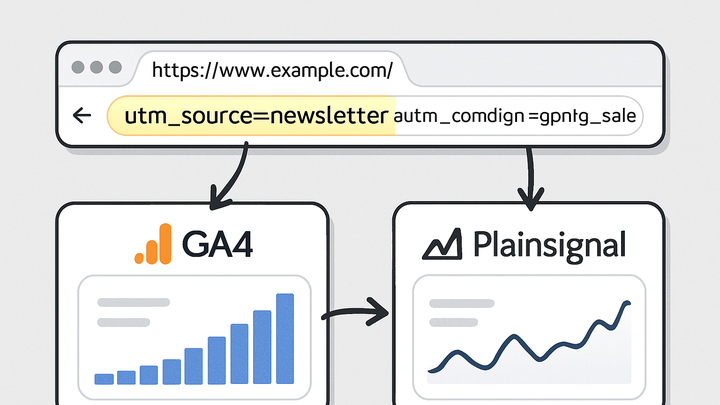Published on 2025-06-22T10:14:00Z
What is UTM Source? Examples and Best Practices
UTM Source is a key UTM parameter used in digital analytics to identify the specific origin of website traffic. By appending utm_source values to URLs, marketers can trace visits back to campaigns, newsletters, social media platforms, or affiliate partners. This clarity is essential for evaluating the performance of marketing channels and making data-driven decisions. Analytics tools such as Google Analytics 4 (GA4) and PlainSignal automatically detect utm_source parameters, allowing you to segment and compare traffic sources in your reports. Whether you’re running paid search campaigns, sending email newsletters, or collaborating with external partners, correctly tagging your URLs ensures accurate attribution and a clear understanding of ROI. Without UTM Source tagging, valuable traffic data can be misclassified, obscuring the true impact of your marketing efforts.
Utm source
UTM Source is a URL parameter identifying traffic origin (e.g., Google, newsletter) for campaign tracking in analytics.
Definition and Purpose
Explore what the UTM Source parameter is and why it’s fundamental for accurately attributing where website traffic originates.
-
What is utm source?
UTM Source is the “utm_source” query parameter appended to a URL that specifies the website, search engine, newsletter, or other source sending traffic to your site.
-
Why it matters
By tagging links with utm_source, marketers can segment incoming traffic by origin in analytics tools, enabling clear attribution of campaign performance and ROI.
How UTM Source Works
Learn how the utm_source parameter operates within URLs and how analytics platforms like GA4 and PlainSignal capture and report this data.
-
Url parameter structure
UTM parameters follow a standard format starting with a question mark (?), followed by key–value pairs separated by ampersands (&). For example:
?utm_source=google&utm_medium=cpc. -
Integration with GA4
In Google Analytics 4, utm_source values are automatically parsed and presented in the User Acquisition and Traffic Acquisition reports under the “Session source/medium” dimension.
-
Integration with PlainSignal
PlainSignal captures full URLs, including UTM parameters, without relying on cookies. It extracts utm_source from incoming page hits and displays it in the campaign report.
-
Example tracking url
Here’s a sample tracking URL:
https://yourwebsitedomain.com/?utm_source=newsletter&utm_medium=email&utm_campaign=spring_sale -
PlainSignal tracking implementation
To integrate PlainSignal on your site, add the following snippet. It automatically captures UTM parameters like utm_source from page URLs:
<link rel="preconnect" href="//eu.plainsignal.com/" crossorigin /> <script defer data-do="yourwebsitedomain.com" data-id="0GQV1xmtzQQ" data-api="//eu.plainsignal.com" src="//cdn.plainsignal.com/plainsignal-min.js"></script>
Implementing UTM Source in Analytics
Step-by-step guide to adding and verifying utm_source tags in your marketing links for accurate data collection.
-
Use a utm builder
Tools like Google’s Campaign URL Builder help ensure parameters like utm_source are formatted correctly and consistently.
-
Tag your urls
Append utm_source along with other UTM parameters to your campaign URLs. For example:
https://example.com/?utm_source=linkedin&utm_medium=social&utm_campaign=webinar. -
Test your tags
Before launching a campaign, click the tagged URL and verify that the utm_source value appears in GA4’s real-time Acquisition report or PlainSignal’s live dashboard.
Best Practices
Tips to ensure your utm_source tagging remains consistent, clear, and useful for long-term analysis.
-
Maintain consistent naming
Standardizing how you name sources prevents data fragmentation.
-
Use lowercase
Always use lowercase letters to avoid duplicate entries like ‘Google’ vs ‘google’.
-
Avoid spaces
Replace spaces with hyphens or underscores to keep URLs valid.
-
Document conventions
Maintain a shared document listing approved source names for your team.
-
-
Be descriptive yet concise
Choose names that clearly indicate the source without being overly long, such as ‘email-newsletter’ instead of ‘email_nl_apr2025’.
-
Use recognizable sources
Limit utm_source values to major channels like ‘facebook’, ‘twitter’, ‘linkedin’, or partner names to maintain clarity.
Common Mistakes to Avoid
Pitfalls that can compromise your campaign tracking accuracy and how to steer clear of them.
-
Missing utm parameters
Forgetting to tag links results in traffic being grouped under ‘direct’ or ‘referral’ sources.
-
Inconsistent naming
Typos or varying case (e.g., ‘Google’ vs ‘google’) fragment data and skew metrics.
-
Overcomplicating source names
Using overly detailed source names (like campaign-specific codes) can make reports hard to read.
-
Ignoring analytics settings
Not aligning UTM conventions with your analytics tool’s default channel grouping can lead to misattribution.
